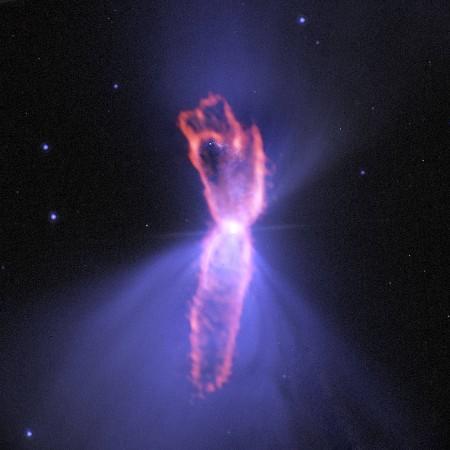
Finally, after more than two decades, astronomers have succeeded in solving the mystery behind one of the coldest objects present in the universe -- Boomerang Nebula.
Also Read: NASA's Hubble telescope spots distant Vermin Galaxy
Located at a distance of 5,000-lightyears away from Earth in constellation Centaurus, the nebula possesses an average temperature of −272.15 °C (1 Kelvin) and hence, is the coldest nebula present in the universe.
The finding was made using the Atacama Large Millimetre/submillimeter Array (ALMA) -- an astronomical interferometer of radio telescopes in the Atacama desert of northern Chile. According to researchers, the reason behind the nebula being so chilly is that a small dying star took a plunge into the centre of another ancient red giant star. This resulted in the emission of most of the matter of the red giant star like gas and debris which is ultra-cold.
The outflow is expanding around 10 times faster than a single star could generate on its own and its temperature has dropped to less than half a degree Kelvin (minus 458.5 degrees Fahrenheit). Zero degrees Kelvin is known as absolute zero, the point at which all thermodynamic motion stops.
The researchers were able to solve this mystery by accumulating accurate calculations about the nebula's extent, age, mass, and kinetic energy with the help of ALMA's observations.
"These new data show us that most of the stellar envelope from the massive red giant star has been blasted out into space at speeds far beyond the capabilities of a single, red giant star, " said Raghvendra Sahai, an astronomer at NASA's Jet Propulsion Laboratory (JPL) in Pasadena, California.
"The only way to eject so much mass and at such extreme speeds is from the gravitational energy of two interacting stars, which would explain the puzzling properties of the ultra-cold outflow. Such close companions may be responsible for the early and violent demise of most stars in the universe," he added.
It's estimated that the red giant star present at the core of the nebula will turn hotter and shrink and end up ionising the gas around it to create a planetary nebula. The planetary nebulae are luminous objects which originate when stars like the Sun or bigger than the Sun shed their outer layers as an expanding shell near the end of their nuclear-fusion-powered life.
Boomerang Nebula represents the very early stages of this process, a so-called pre-planetary nebula.
"The extreme properties of the Boomerang challenge the conventional ideas about such interactions and provide us with one of the best opportunities to test the physics of binary systems that contain a giant star," adds Wouter Vlemmings, an astronomer at Chalmers University of Technology in Sweden and co-author on the study.
When Boomerang Nebula was first observed in 1995, astronomers noted that it was absorbing the light of Cosmic Microwave Background, which is the leftover radiation from Big Bang. This radiation provides the natural background temperature of space -- only 2.725 degrees above absolute zero. For the Boomerang Nebula to absorb that radiation, it had to be even colder than this lingering, dim energy that has been continually cooling for more than 13 billion years.
The new ALMA observations also produced an evocative image of this pre-planetary nebula, showing an hourglass-shaped outflow inside a roughly round ultra-cold outflow. The hourglass outflow stretches more than three trillion kilometres from end to end (about 21,000 times the distance from the Sun to the Earth), and is the result of a jet that is being fired by the central star, sweeping up the inner regions of the ultra-cold outflow like a snowplow.
The ultra-cold outflow is more than 10 times bigger. Travelling more than 150 kilometres per second, it took material at its outer edges approximately 3,500 years to reach these extreme distances after it was first ejected from the dying star.
These conditions, however, will not last long. Even now, the Boomerang Nebula is slowly warming.
"We see this remarkable object at a very special, very short-lived period of its life," noted Lars-Åke Nyman, an astronomer at the Joint ALMA Observatory in Santiago, Chile.
"It's possible these super cosmic freezers are quite common in the universe, but they can only maintain such extreme temperatures for a relatively short time," Nyman concluded.














